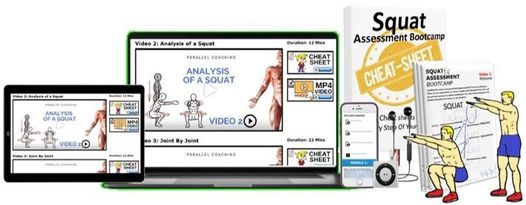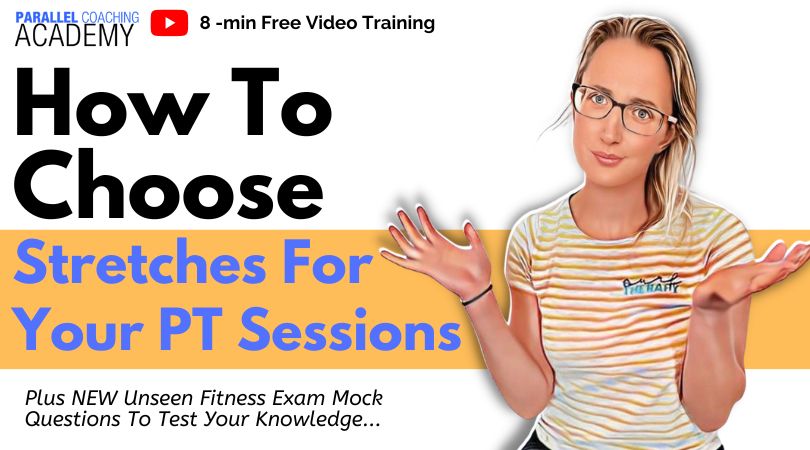Today’s video will help remove the overwhelm of planning so you know how to choose stretches for your PT sessions. This is for you if you are a trainee/newly qualified FITPRO, that often chooses the same stretches for every client or is confused and overwhelmed about which stretches are best.
You’ll learn
- Why stretches are important
- How choosing stretches for your PT sessions should be specific to the INDIVIDUAL
- Using a squat assessment to choose stretches
- How to make adaptations
- Considerations to the client journey
Watch the 8-minute video to outline PNF stretching and the protocol, then test your knowledge with three mock questions.
Watch: How to Choose Stretches for Your PT Sessions
Why are stretches important?
Stretches are a common part of the warm-up and the cooldown, not only as part of the overall journey of the client session but also because they serve a clear anatomical and physiological purpose.
Stretches in the warm-up might be static or dynamic, however, they aim to maintain the current ROM (Range of movement) of the joints and prepare the body for the session that will follow.
The cool-down stretches are usually static stretches and look to progress the ROM of the joints, and increase the length of the muscles that cross those joints. These developmental stretches have an important role including:
- progressing posture – stretching tight muscles will assist in correcting postural compensations
- reducing injury likelihood – good elasticity at the joints will help prevent tears, sprains and strains, as the muscles, tendons and ligaments are familiar with greater ranges.
- improving daily function – Achieving a greater ROM also allows for more efficient movement patterns.
- and improving overall performance – This could show as tangible results of greater depth in a squat or better technique in running
Therefore stretching is a key part of the warm-up and cool-down, but what stretches do you choose…
Stretch choices as a Personal Trainer
Personal Training is a PERSONAL service, it requires you to look at the needs and wants of each INDIVIDUAL, rather than use the same exercises and stretches for each client.
To do this you need to really get to know your client via a consultation, asking them open questions to find out what they really want… and its ok if they don’t say “I need to stretch my hamstrings”.
Your client may want to achieve a goal that appears totally unrelated to improvements in flexibility. However, when you ask more about that goal you find out that increased flexibility and ROM will actually help them achieve part of that goal much more effectively.
Alongside the questions, you ask your client in the consultation. you can also do physical tests to check the current ROM of key joints, and find out which muscles are overly tight in the body.
The best ROM test that you can do in your consultation is a Squat Assessment.
Using a Squat Assessment to choose stretches
A squat assessment is a simple test that gives you the answers to what is going on in your client’s body. By simply watching your client do a series of squats (or overhead squats) you will see all of the little movement quirks and compensations that your client has.
The squat assessment allows you to notice all of the shifts that are made in the body, but then translate that information into a list of muscles that are tight (and overly active), and a list of muscles that are weak (or inactive).
Using these two lists, you now know that you need to include flexibility training and stretches for the tight muscles, and work at activating/ strengthening the weaker muscles. A combination of flexibility and strength work will help to rectify the tight/ weak muscle imbalance. This will inevitably improve their posture, performance and movement efficiency.
For example, if the Hamstrings are tight, you’d include a hamstring developmental stretch in the cool-down. However, if the glutes are weak/inactive you may not include a developmental stretch for that muscle.
Find out more about the Squat Assessment in our Squat Assessment Bootcamp HERE
The Squat Assessment Bootcamp includes 20 video tutorials that teach you the protocol to follow in a squat assessment, and what this means in terms of tight and weak muscles. You’ll also learn how to use this information to influence your planning and help improve client performance.
Example of how to use the results of the squat assessment
Let’s assume that you do a squat assessment with your client and notice they have excessive flexion of the hips. This is presented by leaning the torso too far forward during the squat, instead of keeping the spine parallel to the shins/ lower leg.
Compensation = excessive flexion of the hips
Tight muscles = The hip flexors (iliopsoas and iliacus and rectus femoris) and the Lower back (erector spinae and Quadratus lumborum) amongst others.
Weak muscles = The core (inner core unit and superficial rectus abdominus) and the glutes (gluteus Maximus and medius) amongst others
Therefore you can use this information to influence stretches in the warm-up and cool-down.
You may choose to include more hip mobilising exercises and hip flexor stretches as part of the warm-up to help prepare the body to move better in the main session. This should help “switch off” the overactive tight muscles in the hips so your client can move with less compensation in the main session
Then in the cooldown, you may Choose Stretches for Your PT Sessions that have a particular focus on the hip flexors and the lower back, encouraging the client to progress ROM and develop flexibility. PNF stretches would be a great addition here. Learn more about PNF stretching here.
Write a list of the muscles you’d like to stretch and the stretches you’d ideally like to use with your client, and then ask yourself if that is a position your client feels comfortable in…
Making adaptations for the client
Not all clients can do every stretch equally. Not all clients can get down to the floor, or have the ROM to even get into the starting positions.
This is when you adapt the stretch you’ve chosen. Instead of a floor stretch can you adapt it to sitting on a chair or even standing?
You may even need to change to a totally different stretch that still targets the same muscle. As long as the origins and insertions of the target muscles are moving away from each other, and the client is comfortable it is an effective stretch.
Think about the client’s journey
The next consideration that will affect how to Choose Stretches for Your PT Sessions is the overall client journey.
Once you have your list of stretches that you’d like the client to do, change the order so your client doesn’t need to keep changing height. You could group together all of the standing stretches, all of the kneeling stretches, seated stretches and then finally lying stretches, so the client is gradually working themselves down to the floor.
Test your knowledge with today’s mock questions:
[NOTE: The answers are below the 3rd question]
Q1: What is NOT a benefit of regular stretching?
A. Increased Range of Movement
B. Reduced Range of Movement
C. Improve Posture
D. Reduced likelihood of injury
Q2: What factors influence stretch choice in a PT session?
A. Client journey, ability, needs and tight muscles
B. The stretches I like to do as a PT
C. The quickest stretches so the cooldown can be as short as possible
D. My preferences, client preferences and client journey
Q3: What does ROM stand for?
A. Repetition of Mobility
B. Repetitions of Movement
C. Range of Movement
D. Ready of Movement
Answers to the mock questions are :
Question 1= B, Question 2 = A, Question 3 = C
If you want more mock questions like this, then you can download more Free Mock Questions: DOWNLOAD NOW
Learn the Squat Assessment and Use It Immediately With Confidence

Fill your knowledge gaps, by learning “what to look for” when observing client posture and technique.
Plus, identify client postural compensations, and learn how to correct them.
- Observe your client’s movement in detail
- Recognise postural compensations in your client
- Identify joints that are misaligned
- Understand which muscles are tight and weak in the body
- Learn how to effectively program to correct compensations
Click the link to find out more and join us:
https://courses.parallelcoaching.co.uk/products/squat-assessment-bootcamp/
Dedicated to More
Hayley “How to Choose Stretches for Your PT Sessions?” Bergman
Parallel Coaching
P.S. You can also find us on the following platforms:
Instagram: https://www.instagram.com/parallelcoaching
Facebook: https://www.facebook.com/ParallelCoaching
Twitter: https://twitter.com/ParallelCoach
YouTube: http://bit.ly/2F1Z1bs
Read more Stretching blogs: HERE
How to Choose Stretches for Your PT Sessions, Choose Stretches for Your PT Sessions Choose Stretches, stretching, flexibility, stretch, benefits of stretching, warm up, cool down, personal trainer sessions, planning, PT planning,
How to Choose Stretches for Your PT Sessions; Choose Stretches for Your PT Sessions Choose Stretches; stretching; flexibility; stretch; benefits of stretching; warm up; cool down; personal trainer sessions; planning; PT planning;


